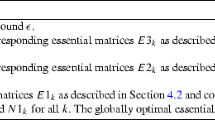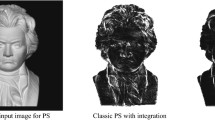Abstract
We present an algorithm to estimate the parameters of a linear model in the presence of heteroscedastic noise, i.e., each data point having a different covariance matrix. The algorithm is motivated by the recovery of bilinear forms, one of the fundamental problems in computer vision which appears whenever the epipolar constraint is imposed, or a conic is fit to noisy data points. We employ the errors-in-variables (EIV) model and show why already at moderate noise levels most available methods fail to provide a satisfactory solution. The improved behavior of the new algorithm is due to two factors: taking into account the heteroscedastic nature of the errors arising from the linearization of the bilinear form, and the use of generalized singular value decomposition (GSVD) in the computations. The performance of the algorithm is compared with several methods proposed in the literature for ellipse fitting and estimation of the fundamental matrix. It is shown that the algorithm achieves the accuracy of nonlinear optimization techniques at much less computational cost.
Similar content being viewed by others
References
Boufama, B. and Mohr, R. 1995. Epipole and fundamental matrix estimation using virtual parallax. In Proc. 5th Int. Conf. on Computer Vision, Boston, MA, pp. 1030–1036.
Cabrera, J. and Meer, P. 1996. Estimating ellipses by the bootstrap method for bias correction. IEEE Trans. on Pattern Analysis and Machine Intelligence, 18:752–756.
Chojnacki, W., Brooks, M.J., and Hengel, A. van den, 1999. Fitting surfaces to data with covariance information: Fundamental methods applicable to computer vision. Technical Report TR-99-03. Department of Computer Science, University of Adelaide, Australia.
Faugeras, O. 1993. Three—Dimensional Computer Vision. MIT Press: Cambridge, MA.
Faugeras, O. 1995. Stratification of three-dimensional vision: projective, affine and metric representations. Journal of Optical Society of America, 12:465–484.
Fitzgibbon, A.W., Pilu, M., and Fisher, R.B. 1999. Direct least squares fitting of ellipses. IEEE Trans. on Pattern Analysis and Machine Intelligence, 21:476–480.
Fuller, W.A. 1987. Measurement Error Models. Wiley: New York.
Golub, G.H. and Van Loan, C.F. 1990 Matrix Computations, 2nd ed. Johns Hopkins University Press: Baltimore, MD.
Hartley, R.I. 1997a. In defense of the eight-point algorithm. IEEE Trans. on Pattern Analysis and Machine Intelligence, 19:580–593.
Hartley, R.I. 1997b. Minimizing algebraic error. In Proc. DARPA 1997 Image UnderstandingWorkshop, New Orleans, LA, pp. 631–637.
Kanatani, K. 1993. Unbiased estimation and statistical analysis of 3-D rigid motion from two views. IEEE Trans. on Pattern Analysis and Machine Intelligence, 15:37–50.
Kanatani, K. 1994. Statistical bias of conic fitting and renormalization. IEEE Trans. on Pattern Analysis and Machine Intelligence, 16:320–326.
Kanatani, K. 1996. Statistical Optimization for Geometric Computation: Theory and Practice. North-Holland: Amsterdam, The Netherlands.
Leedan, Y. 1997. Statistical analysis of quadratic problems in computer vision. Ph.D. Thesis. Department of Electrical and Computer Engineering. Rutgers University. Available at web-site www.caip.rutgers/riul/research/theses.html
Luong, Q.-T. and Faugeras, O. 1996. The fundamental matrix: Theory, algorithms and stability analysis. Int. Journal on Computer Vision, 17:43–76.
Matei, B. and Meer, P. 1999. Optimal rigid motion estimation and performance evaluation with bootstrap. In Proc. 1999 IEEE Conference on Computer Vision and Pattern Recognition, Fort Collins, CO, Vol. 1, pp. 339–345.
Meer, P., Mintz, D., Rosenfeld, A, and Kim, D.Y. 1991. Robust regression methods for computer vision: A review. Int. J. Computer Vision, 6:59–70.
Mendel, J.M. 1995. Lessons in Estimation Theory for Signal Processing, Communication and Control. Prentice Hall: Englewood Cliffs, NJ.
Mirsky, L. 1990. An Introduction to Linear Algebra. Dover: Mineola, NY.
Ponce, J. and Genc, Y. 1996. Epipolar geometry and linear subspace methods:Anewapproach to weak calibration. In Proc. 1996 IEEE Conf. on ComputerVision andPattern Recognition, San Francisco, CA, pp. 776–781.
Sampson, P.D. 1982. Fitting conic sections to “very scattered” data: An iterative refinement of the Bookstein algorithm. Computer Graphics Image Processing, 18:97–108.
Taubin, G. 1991. Estimation of planar curves, surfaces and nonplanar space curves defined by implicit equations with applications to edge and range image segmentation. IEEE Trans. on Pattern Analysis and Machine Intelligence, 13:1115–1138.
Taubin, G. 1993. An improved algorithm for algebraic curve and surface fitting. In Proc. 4th Int. Conf. on Computer Vision, Berlin, Germany, pp. 658–665.
Torr, P.H.S. 1995. Motion segmentation and outlier detection. Ph.D Thesis, OUEL 1987/93, Department of Engineering Science, University of Oxford.
Torr, P.H.S. and Murray, D.W. 1997. The development and comparison of robust methods for estimating the fundamental matrix. Int. Journal on Computer Vision, 24:271–300.
Van Huffel, S. and Vandewalle, J. 1989. Analysis and properties of GTLS in problem AX ≈ B. SIAM Journal on Matrix Analysis and Applications, 10:294–315.
Van Huffel, S. and Vandewalle, J. 1991. The Total Least Squares Problem. SIAM: Philadelphia, PA.
Zhang, Z. 1997. Parameter estimation techniques: A tutorial with application to conic fitting. Image and Vision Computing, 15:59–76.
Zhang, Z. 1998a. Determining the epipolar geometry and its uncertainty: A review. Int. Journal on Computer Vision, 27:161–195.
Zhang, Z. 1998b. On the optimization criteria used in two-view motion analysis. IEEE Trans. on Pattern Analysis and Machine Intelligence, 20:717–729.
Zhang, Z., Deriche, D., Faugeras, O., and Luong Q.T. 1995. A robust technique for matching two uncalibrated images through the recovery of unknown epipolar geometry. Artificial Intelligence, 78:87–119.
Author information
Authors and Affiliations
Rights and permissions
About this article
Cite this article
Leedan, Y., Meer, P. Heteroscedastic Regression in Computer Vision: Problems with Bilinear Constraint. International Journal of Computer Vision 37, 127–150 (2000). https://doi.org/10.1023/A:1008185619375
Issue Date:
DOI: https://doi.org/10.1023/A:1008185619375




